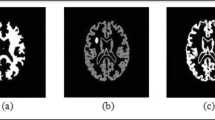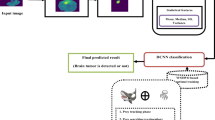Abstract
In the research field of computer vision and image recognition, images need to be preprocessed, and image segmentation is an essential method of image preprocessing. Researchers usually use fuzzy clustering algorithms for image preprocessing. The fuzzy c-means (FCM) method is easy to implement, so it is the most widely used and more successful among many fuzzy clustering algorithms. However, the algorithm is highly sensitive to randomly initialized cluster centers, and the final result is highly likely to be a local optimal value. Therefore, we use quantum-inspired ant lion optimizer (QALO) to optimize FCM clustering method and propose an efficient hybrid clustering algorithm called QALOFCM. The UCI dataset is used as an experimental dataset to testify the clustering effect of the method and compare and analyze the clustering results with other well-known clustering algorithms. The algorithm is designed to perform image segmentation experiments on Simulated Brain Database. The final comparative experiment can draw a conclusion that the hybrid method can not only be effectively used for fuzzy clustering, but also can be effectively applied in image segmentation.






Similar content being viewed by others
Data Availability
The datasets analyzed during the current study are available in the Machine Learning Repository, archive.ics.uci.edu, and Simulated Brain Database, brainweb.bic.mni.mcgill.ca.
References
Bache K, Lichman M (2013) UCI Machine learning repository. University of California, Irvine, CA
Benioff P (1982) Quantum mechanical Hamiltonian models of Turing machines. J Stat Phys 29(3):515–546
Beyer HG, Schwefel HP (2002) Evolution strategiesCA Comprehensive Introduction. Nat Comput 1:3–52
Bezdek JC (1974) Cluster validity with fuzzy sets. J Cybernet 3:58–73
Bezdek JC (1981) Pattern recognition with fuzzy objective function algorithms. Plenum, New York
Bezdek JC, Ehrlich R, Full W (1984) FCM: The fuzzy c-means clustering algorithm. Comput Geosci 10(2–3):191–203
Bezdek JC (1975) Mathematical models for systematics and taxonomy. In: Proceedings of the 8th international conference on numerical. taxonomy, San Francisco, CA, pp 143–165
Bui DT, Ngo PTT, Pham TD et al (2019) A novel hybrid approach based on a swarm intelligence optimized extreme learning machine for flash flood susceptibility mapping. CATENA 179:184–196
Chaghari A, Feizi-Derakhshi MR, Balafar MA (2018) Fuzzy clustering based on Forest optimization algorithm. J King Saud Univ—Comput Inf Sci 30(1):25–32
Chen J, Qi X, Chen L et al (2020) Quantum-inspired ant lion optimized hybrid k-means for cluster analysis and intrusion detection. Knowl-Based Syst 203:106167
Cocosco CA, Kollokian V, Kwan RKS et al (1997) Brainweb: Online interface to a 3D MRI simulated brain database. NeuroImage
Das S, Abraham A, Konar A (2008) Particle swarm optimization and differential evolution algorithms: technical analysis, applications and hybridization perspectives. Advances of computational intelligence in industrial systems. Springer, Berlin, Heidelberg, pp 1–38
Das P, Naskar SK, Patra SN (2018) Hardware efficient FIR filter design using global best steered quantum inspired cuckoo search algorithm. Appl Soft Comput 71:1–19
Demšar J (2006) Statistical comparisons of classifiers over multiple data sets. J Mach Learn Res 7:1–30
Fang W, Sun J, Chen H et al (2016) A decentralized quantum-inspired particle swarm optimization algorithm with cellular structured population. Inf Sci 330:19–48
Feynman RP (1982) Simulating physics with computers. Int J Theor Phys 21(6):467–488
Figueiredo E, Macedo M, Siqueira HV et al (2019) Swarm intelligence for clustering—a systematic review with new perspectives on data mining. Eng Appl Artif Intell 82:313–329
Fu KS, Mui JK (1981) A survey on image segmentation. Pattern Recognit 13(1):3–16
Gamino-Sánchez F, Hernández-Gutiérrez IV, Rosales-Silva AJ et al (2018) Block-Matching Fuzzy C-Means clustering algorithm for segmentation of color images degraded with Gaussian noise. Eng Appl Artif Intell 73:31–49
Guo L, Chen L, Chen CLP et al (2018) Integrating guided filter into fuzzy clustering for noisy image segmentation. Digit Signal Prog 83:235–248
Jiao X, Chen Y, Dong R (2020) An unsupervised image segmentation method combining graph clustering and high-level feature representation. Neurocomputing 409:83–92
Jie L, Liu W, Sun Z et al (2017) Hybrid fuzzy clustering methods based on improved self-adaptive cellular genetic algorithm and optimal-selection-based fuzzy c-means. Neurocomputing 249:140–156
Kang K, Bae C, Yeung HWF et al (2018) A hybrid gravitational search algorithm with swarm intelligence and deep convolutional feature for object tracking optimization. Appl Soft Comput 66:319–329
Konar D, Bhattacharyya S, Sharma K et al (2017) An improved hybrid quantum-inspired genetic algorithm (HQIGA) for scheduling of real-time task in multiprocessor system. Appl Soft Comput 53:296–307
Kong Y, Wu J, Yang G et al (2019) Iterative spatial fuzzy clustering for 3D brain magnetic resonance image supervoxel segmentation. J Neurosci Methods 311:17–27
Krinidis S, Chatzis V (2010) A robust fuzzy local information C-means clustering algorithm. IEEE Trans Image Process 19(5):1328–1337
Li C, Zhou J, Kou P et al (2012) A novel chaotic particle swarm optimization based fuzzy clustering algorithm. Neurocomputing 83:98–109
Mahajan M, Nimbhorkar P, Varadarajan K (2009) The planar k-means problem is NP-hard. International workshop on algorithms and computation. Springer, Berlin, Heidelberg, pp 274–285
Mavrovouniotis M, Li C, Yang S (2017) A survey of swarm intelligence for dynamic optimization: algorithms and applications. Swarm Evol Comput 33:1–17
Mirjalili S (2015) The ant lion optimizer. Adv Eng Softw 83:80–98
Miyamoto S, Umayahara K (2000) Methods in hard and fuzzy clustering. Soft computing and human-centered machines. Springer, Tokyo, pp 85–129
Nayak J, Naik B, Kanungo DP et al (2018) A hybrid elicit teaching learning based optimization with fuzzy c-means (ETLBO-FCM) algorithm for data clustering. Ain Shams Eng J 9(3):379–393
Pradhan K, Basu S, Thakur K et al (2020) Imprecise modified solid green traveling purchaser problem for substitute items using quantum-inspired genetic algorithm. Comput Ind Eng 147:106578
Raja JB, Pandian SC (2020) PSO-FCM based data mining model to predict diabetic disease. Comput Meth Programs Biomed 196:105659
Shang R, Chen C, Wang G et al (2020) A thumbnail-based hierarchical fuzzy clustering algorithm for SAR image segmentation. Signal Process 171:107518
Sheykhizadeh S, Naseri A (2018) An efficient swarm intelligence approach to feature selection based on invasive weed optimization: application to multivariate calibration and classification using spectroscopic data. Spectroc A-Molec Biomolec Spectr 194:202–210
Silva Filho TM, Pimentel BA, Souza RMCR et al (2015) Hybrid methods for fuzzy clustering based on fuzzy c-means and improved particle swarm optimization. Expert Syst Appl 42(17–18):6315–6328
Silva-Santos CH, Morais JVF, Bertelli F et al (2020) Purification of naphthalene by zone refining: mathematical modelling and optimization by swarm intelligence-based techniques. Sep Purif Technol 234:116089
Singh P (2020) A neutrosophic-entropy based clustering algorithm (NEBCA) with HSV color system: A special application in segmentation of Parkinson’s disease (PD) MR images. Comput Meth Programs Biomed 189:105317
Srikanth K, Panwar LK, Panigrahi BK et al (2018) Meta-heuristic framework: quantum inspired binary grey wolf optimizer for unit commitment problem. Comput Electr Eng 70:243–260
Taherdangkoo M, Bagheri MH (2013) A powerful hybrid clustering method based on modified stem cells and Fuzzy C-means algorithms. Eng Appl Artif Intell 26(5–6):1493–1502
Xie XL, Beni A (1991) Validity measure for fuzzy clustering. IEEE Trans Pattern Anal Mach Intell 3:841–846
Yang Y, Wang R, Feng C (2020) Level set formulation for automatic medical image segmentation based on fuzzy clustering. Signal Process-Image Commun 87:115907
Yu C, Cai Z, Ye X et al (2020) Quantum-like mutation-induced dragonfly-inspired optimization approach. Math Comput Simul 178:259–289
Yuan X, Wang P, Yuan Y et al (2015) A new quantum inspired chaotic artificial bee colony algorithm for optimal power flow problem. Energy Conv Manag 100:1–9
Zhu H, Qi X, Chen F et al (2019) Quantum-inspired cuckoo co-search algorithm for no-wait flow shop scheduling. Appl Intell 49(2):791–803
Acknowledgements
This work is supported by the National Natural Science Foundation of China (61972438) and Key Research and Development Projects in Anhui Province (202004a05020002).
Funding
This study was funded by the National Natural Science Foundation of China (61972438) and Key Research and Development Projects in Anhui Province (202004a05020002).
Author information
Authors and Affiliations
Contributions
All authors contributed to the study conception and design. J. Chen and X. Qi conceived the presented idea. J. Chen carried out the experiment and wrote the manuscript with support from X. Qi, F. Chen, and G. Cheng. F. Chen and G. Cheng helped in supervising the findings of this work. All authors read and approved the final manuscript.
Corresponding author
Ethics declarations
Conflict of interest
We declare that this research does not have any conflicts of interest.
Ethical approval
This chapter does not contain any studies with human participants or animals performed by any of the authors.
Informed consent
Additional informed consent was obtained from all individual participants for whom identifying information is included in this chapter.
Additional information
Publisher's Note
Springer Nature remains neutral with regard to jurisdictional claims in published maps and institutional affiliations.
Rights and permissions
About this article
Cite this article
Chen, J., Qi, X., Chen, F. et al. Quantum-inspired ant lion-optimized hybrid fuzzy c-means method for fuzzy clustering and image segmentation. Soft Comput 25, 15021–15034 (2021). https://doi.org/10.1007/s00500-021-06391-z
Accepted:
Published:
Issue Date:
DOI: https://doi.org/10.1007/s00500-021-06391-z




